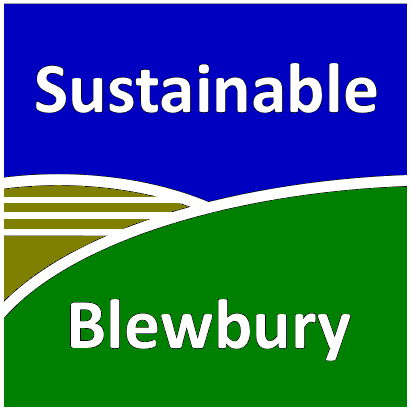
This page describes our permaculture pilot project and the ideas behind it.
Permaculture principles
The aim of permaculture is to work with nature to create a self-sustaining ecosystem that mostly looks after itself, with only minimal maintenance required. In the process the soil is enriched, producing a good crop yield every year while greatly improving biodiversity.
A wide range of plant species is chosen, to encourage beneficial relationships so that all become more resilient and less susceptible to pests and diseases. The plants chosen have different functions which can enhance each other’s growth – for example some may deter pests while others fix nitrogen. This can also create habitats for wildlife, which also enhances diversity.
Working with nature means taking account of and using the attributes of the site, such as water availability, sun and shade, wind direction and soil variation.
Once the site is underway, the aim is to create no waste, or as little as possible. Nothing should have to be removed from the site and thrown away. And after the initial planting stage, nothing should have to be brought in.
Some suggested sources of further information are given at the end.
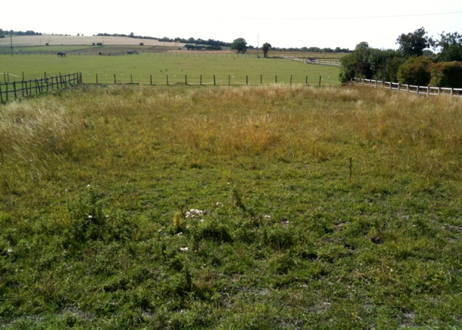
Aims of the project
The main aim of our pilot permaculture project is to create a small orchard garden. This will:
- produce fruit, perennial vegetables and herbs
- provide a good habitat for wildlife
- be a beautiful and pleasant place to visit
- educate by demonstrating long-term, sustainable methods of growing
- try out ideas such as companion planting, to see how well they work
The Woodway Permaculture Project
The plot for the project is 0.44 acres of open field. It had not been cultivated in recent years, but was used for occasional grazing by horses, and before that for Tamworth pigs. It is quite exposed and windy, with chalky, alkaline soil. The first photo shows the plot (looking west) before any work had been done.
The shelter-belt hedge
The project began in February–March 2011 by planting a mixed, native-plant hedge on the south and west sides of the plot. This provides a shelter belt from the prevailing wind for the garden. The 400-odd plants in the hedge also provide nourishment (including a variety of berries) and shelter for wildlife. The leaf fall from the hedge will begin to add organic matter to the soil, improving its structure and making it less alkaline.
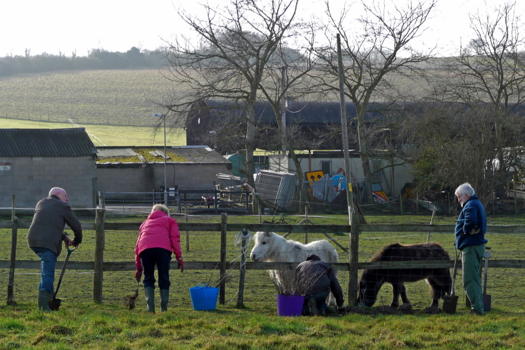
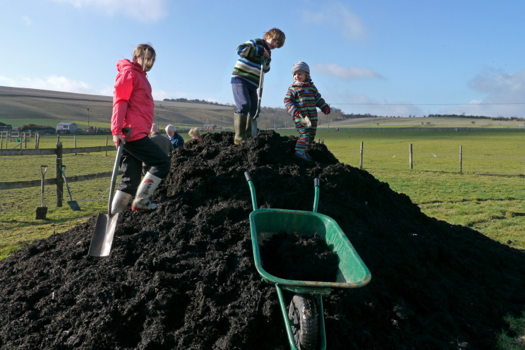
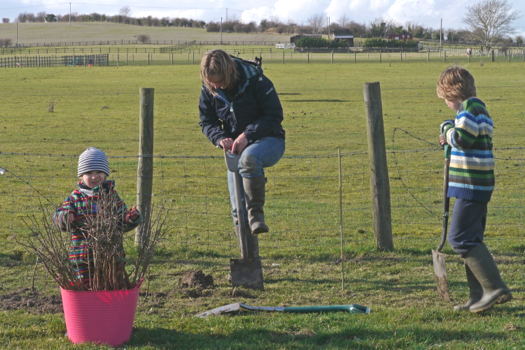
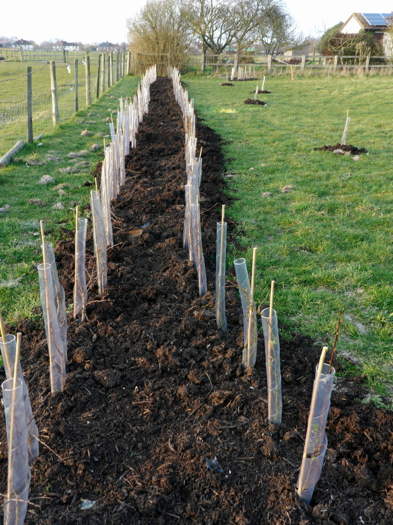
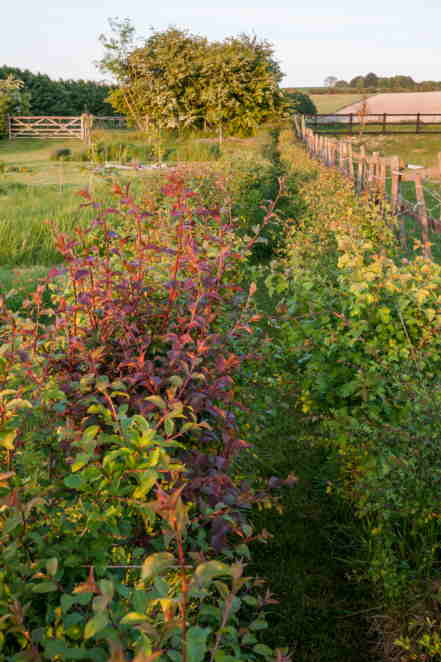
The main planting day, in February 2011, was a wonderful occasion that saw most of the hedge planted by an enthusiastic group of helpers. A huge mound of compost, made from the contents of brown garden-waste bins, had been provided. We planted hawthorn, hazel, crab apple, wild plum, blackthorn (sloe), dog rose, purging buckthorn, elder and guelder rose.
See our photo gallery for a full set of pictures before, during and after planting the hedge.
The first year had some tough conditions for the hedge, with an exceptionally dry spring. However, all but a few of the 400-plus plants survived, despite the field being very exposed and having poor soil. The last photo shows the hedge in May 2013, after two summers of growth.
Fruit trees and bushes
The second stage was to plant some fruit trees and bushes. We started in October–December 2011 by mulching the upper area of the field to suppress the grass and to enrich the soil. We spread cardboard and covered it with horse manure from the neighbouring farm and the local stables. However, the cardboard was messy and did not work well. For clearing beds in subsequent years we put down manure under a water-permeable layer of woven black polyethylene sheeting.
In December 2011 we planted a dozen fruit trees, including (among others) cherries, medlar, quince, gages and apple. We also planted a wide variety of soft fruit: raspberries, currants (black, red and white), gooseberries, etc. (Photos below, and more in our photo gallery.) There is a separate diagram (pdf) of the trees and soft fruit that have been planted to date as well as some information (pdf) about the different types of trees we chose.

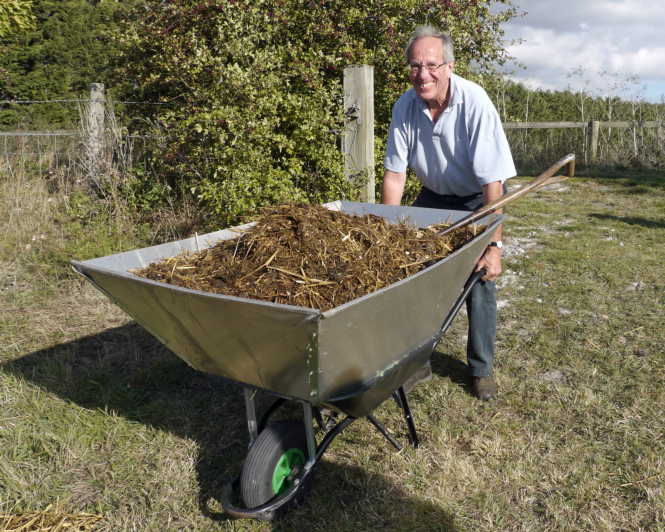
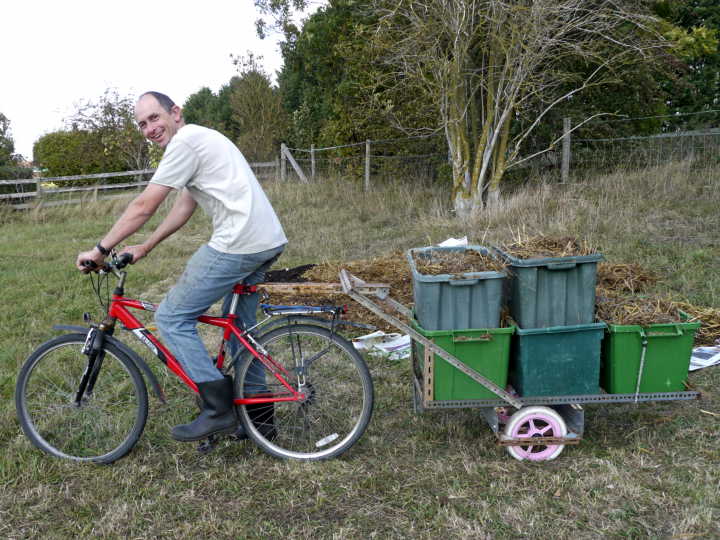
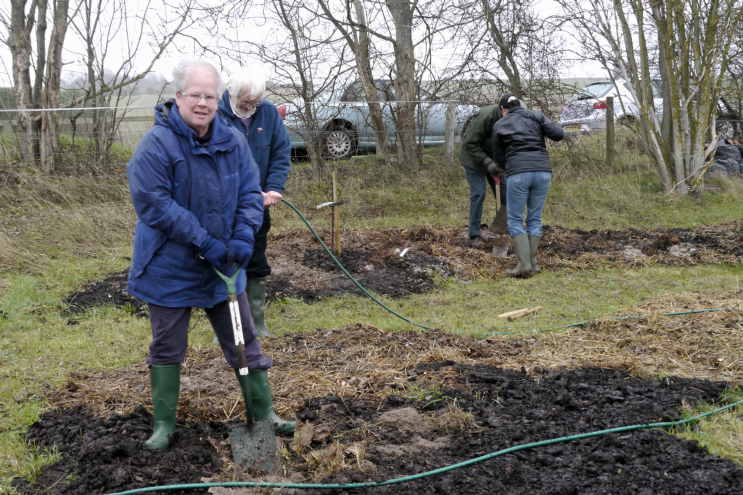
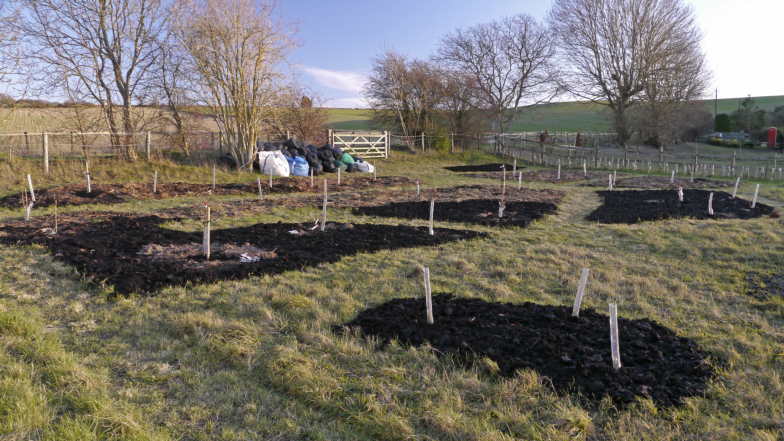
In April and May 2012, including a planting and weeding working party in early May, we planted a wide variety of perennial herbs and ground-cover plants in the cultivated areas (photos below: whitecurrant bush in blossom, weeding, thyme plant). The last photo is a general view taken in August 2012.
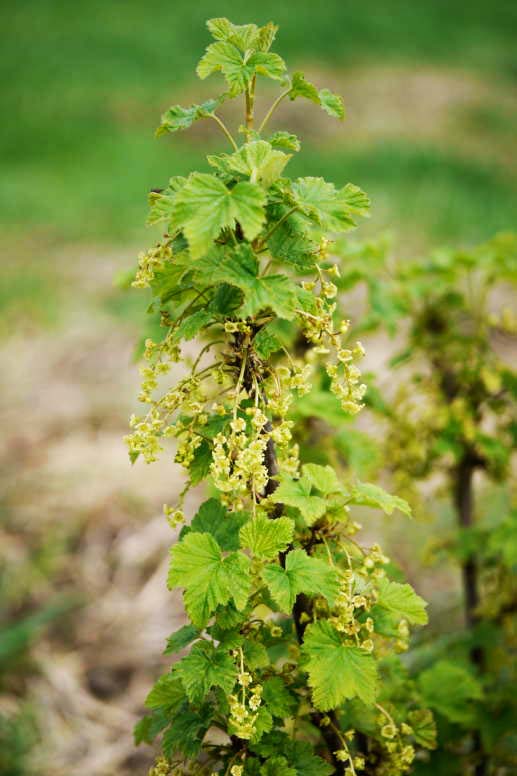
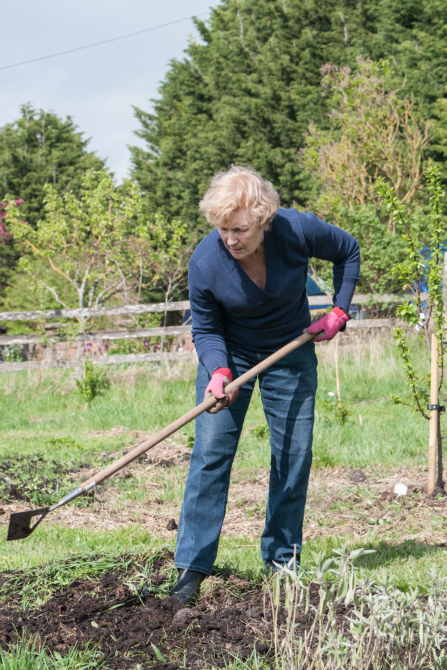
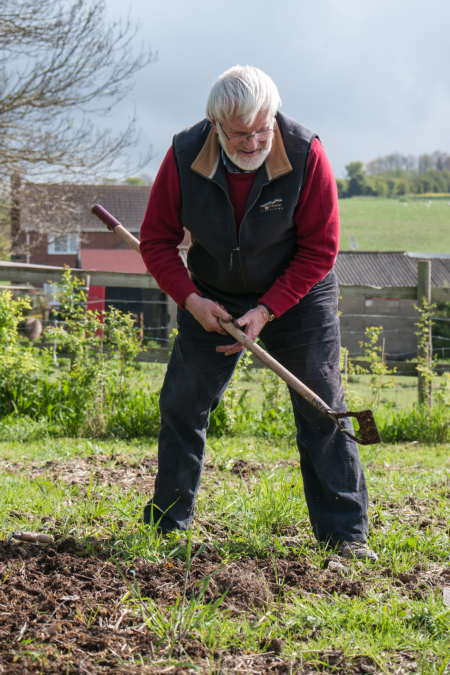

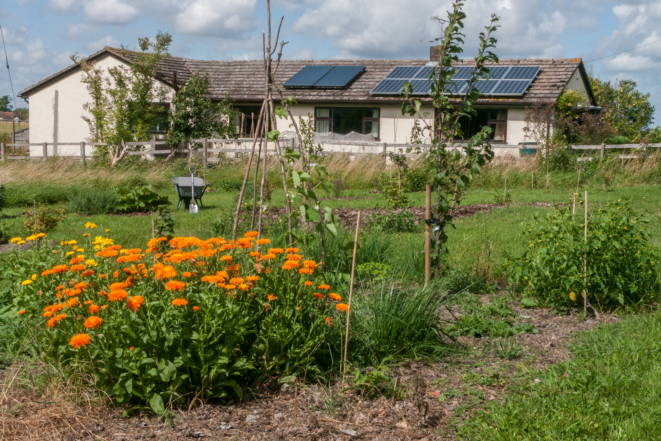
In November and December 2012 we added 10 additional fruit trees: two varieties of pears, a purple and a yellow plum, mirabelle, damson, crab apple, cobnut, sweet almond and black mulberry. We also planted a low hedge using rosa rugosa, which produces very large edible rosehips, across the middle of the field to give some shelter as well as divide up and decorate the plot.
In March and April 2013 we added lots of autumn raspberries and asparagus (which unfortunately failed), as well as a wide variety of perennial herbs and other ground-cover plants.
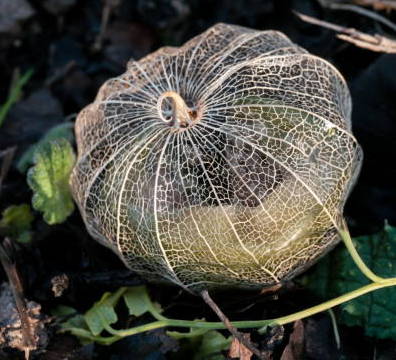

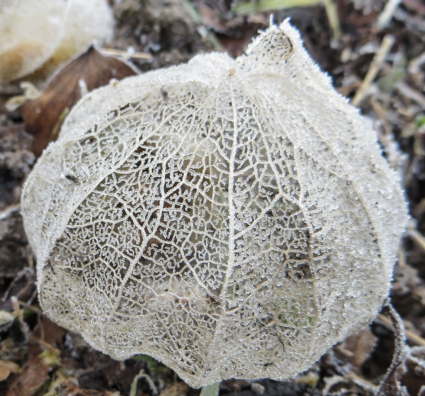
We have built compost heaps from scrap wood, and some discarded wood packing crates, filling them with the large quantity of leaves collected during the village clean-up days in the autumn. The leaf mould is used mainly to mulch around the trees and soft fruit bushes to suppress weeds and provide some nourishment.
In February 2013, aided and guided by the expertise and hard work of Lawrence Graham, a living willow shelter was constructed. The willow has grown to give a shaded, green space where we, and especially children, can sit and enjoy the site. The photos show the shelter being constructed, ready to grow, and a view of it taken in May 2013.
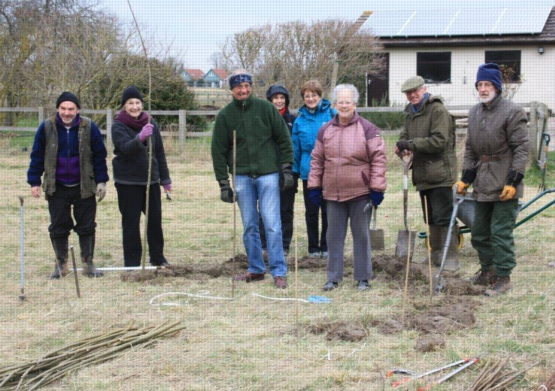
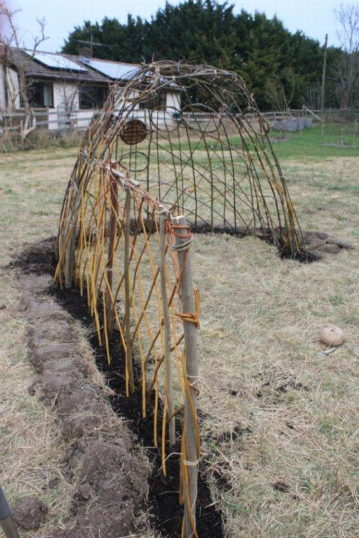
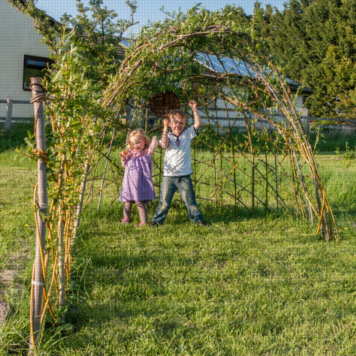
At the end of June we had a working party to clear the ‘flourishing’ weeds – the first photo below shows the working party, the second one an Austrian scythe in action, and the third one a view in August including our new sign. From July to September we had some soft fruit to sell at the Blewbury Garden Market, most notably a good quantity of blackcurrant jam using fruit from the project. We also put up for sale redcurrants, whitecurrants, courgettes and french beans. The herbs have attracted huge numbers of bees and a wonderful variety of butterflies, including the Painted Lady in the fourth photo. In September we had another working party to tidy up for the winter, and a celebration barbecue for our helpers and people who have donated plants.
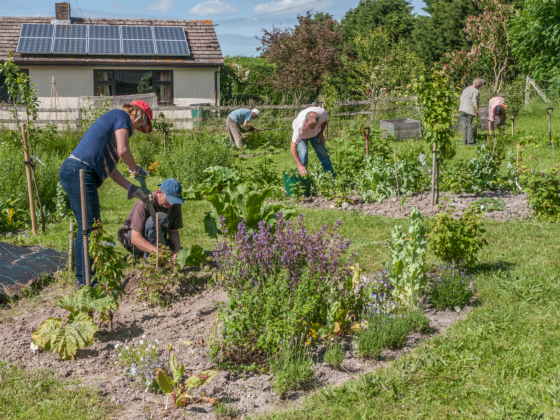
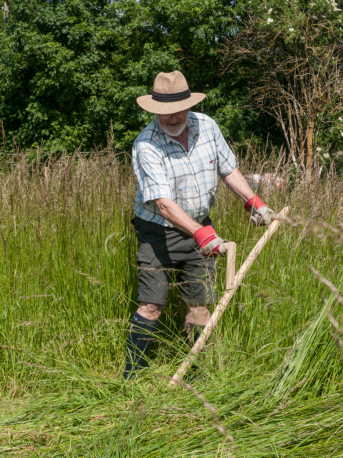
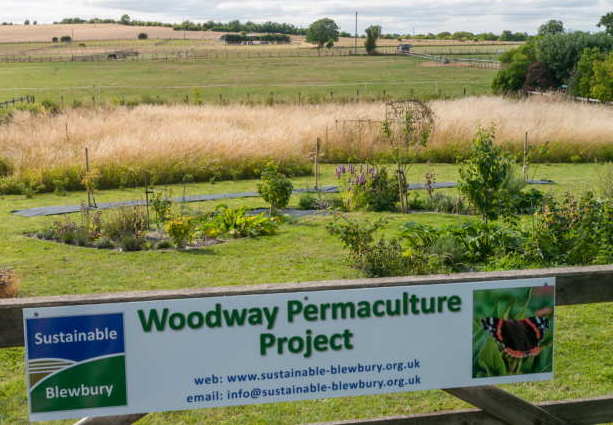
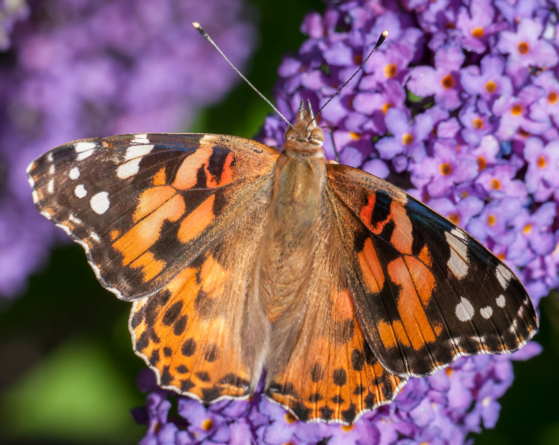
In December 2013 we planted more trees: two types of cherry, a Bramley apple, an early purple plum, a greengage and a flowering lime, as well as more fruit bushes: two each of blackberry, tayberry, boysenberry, jostaberry and kiwi berry. These are all on our diagram (pdf) and there is more information on our trees here (pdf).
The 2014 season was quite successful. Trees and bushes started to produce reasonable quantities of fruit, and the ground cover on some of the more established plots started taking over from some of the weeds. We sold a variety of things at the Blewbury Garden Market: quite a few globe artichokes, autumn raspberries, French beans, Early Transparent gages, Beth and Concorde pears, and jam (rhubarb & ginger, blackcurrant, and blackcurrant & raspberry). Crops with smaller yields were shared among the people working on the project: recurrants, Japanese wineberries, wild strawberries, Marjorie Seedling plums and medlars. Some of these were from trees in their first year on the plot.
In September we had a very enjoyable and successful open day, to explain to visitors what we are doing and show them our progress. A number of children who came had a wonderful time looking at the plants and playing in the long grass and willow shelter.
The first photo below shows springtime tea in the willow shelter, the second is an early summer view of the plot, and the third the open day.
We had sold our first Jerusalem artichokes via BGM Extra at the Post Office in February 2014. In January–March 2015 we had our first really big permaculture crop – well over 20 kg of Jerusalem artichokes were lifted (fourth photo below), with about two-thirds sold at the Post Office and the rest for people who work on the permaculture plot. In spring 2015 we lifted the black covers on some new plots and covered up a few more new plots to be ready for planting in 2016. The fifth photo shows our almond tree in blossom.
In May we also had a visit by about 30 people, from Abingdon Carbon Cutters and Green Appleton, who were interested in permaculture and our experience of starting a community garden (sixth photo below). There was a lot of animated discussion, probing questions, and general interest in what we had done and our plans. One visitor said in an email: “The garden itself was more fun and less earnest than I had expected, and what a lovely setting!”
During the spring, summer, autumn and early winter we sold quite a lot of produce and preserves made from our produce: In April–May 2015 we had a large quantity of rhubarb, selling dozens of bags at the Post Office and the Blewbury Garden Market and also a big batch of rhubarb and ginger jam. We sold and used a lot of globe artichokes, gooseberries and gooseberry jam, boysenberries, redcurrants, blackcurrant and also mixed berry jam, plums, a lot of autumn raspberries, quince jelly, and then in December back to Jerusalem artichokes. Income from the sales was more than enough to cover petrol and servicing for the lawnmower, some new plants, and sundries such as some permeable hosepipe for watering (especially useful for the willow shelter) and netting for fruit bushes.
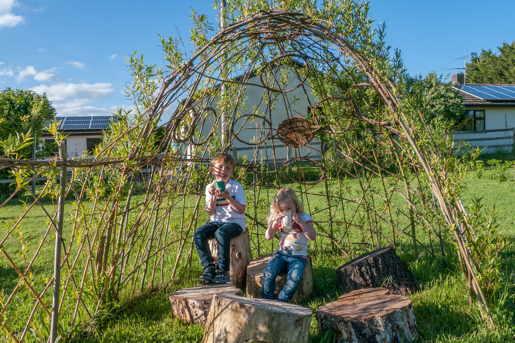
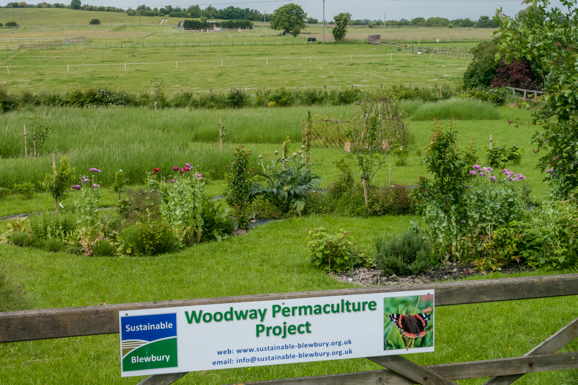
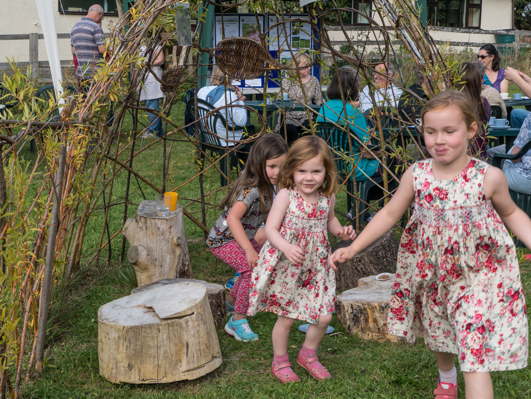
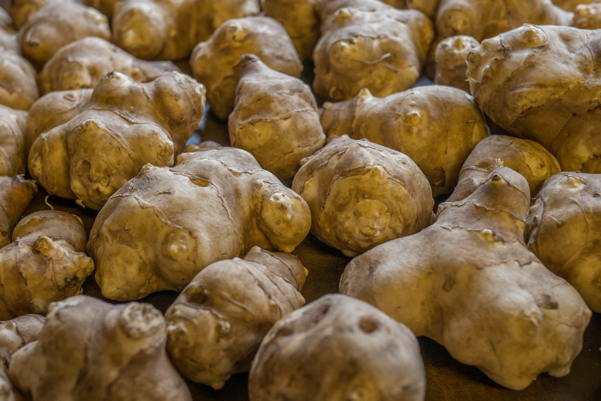
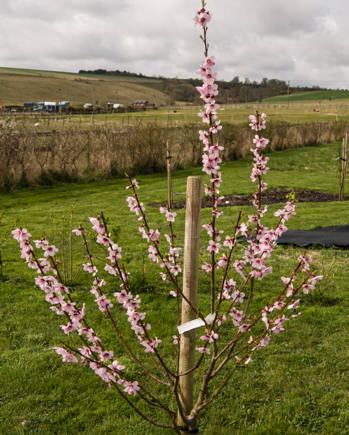
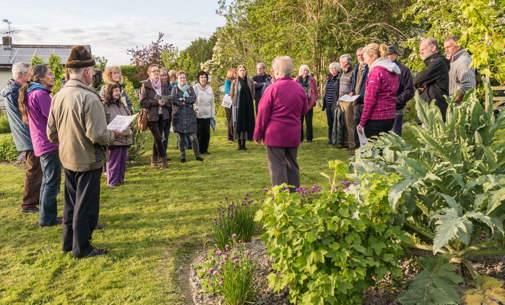
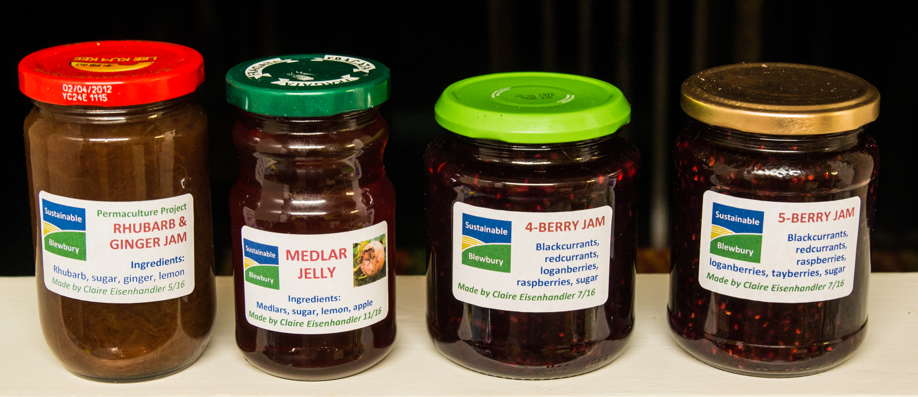
In 2016 we added a few new bushes, but mainly it was a year of consolidation and increased yield in many cases, especially soft fruit. The perennial ground-cover was working in some plots, but sadly bindweed had taken over elsewhwere, and we added quite a lot of comfrey to use as ‘green manure’. Small crops from trees and bushes that were only starting to produce the crops went to the people doing the work (e.g. gages, plums, morello cherries, Japanese wineberries, cobnuts), but where there was enough to sell we used the proceeds to cover running costs – we produce some interesting things that are hard to find in shops. We started and ended the year with Jerusalem artichokes. In spring we had lots of rhubarb, then globe artichokes. Soft fruit sold fresh included strawberries, redcurrants, boysenberries and autumn raspberries, as well as French beans and pears. A lot of the fruit was made into jam: rhubarb and ginger, gooseberry and elderflower, mixed berries (blackcurrants, redcurrants, raspberries, boysenberries and tayberries), jostaberry, and various jellies: redcurrant, crabapple and rosehip, and medlar. The photos below show a hard frost on the first day of December.
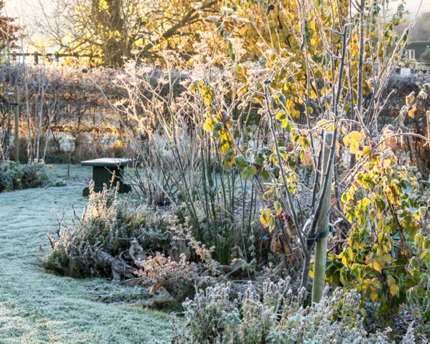
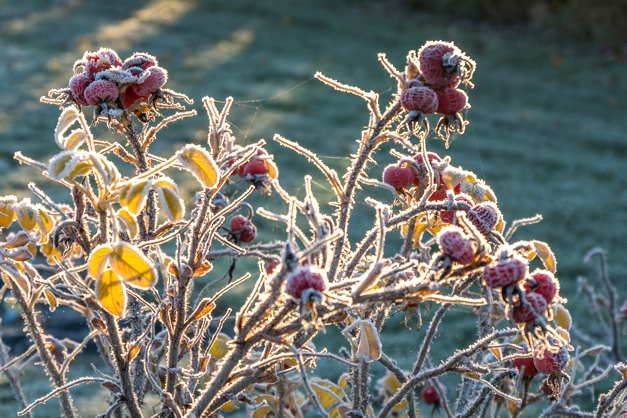
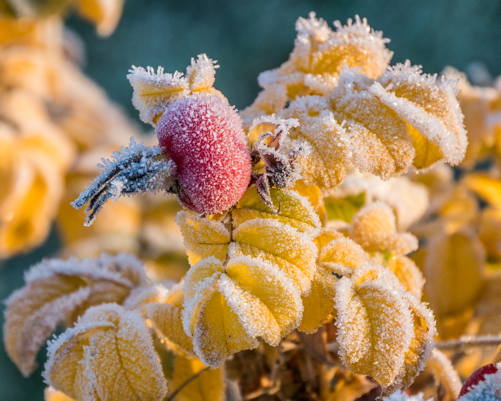
2017 was another year of consolidation. At the end of November we replaced a plum tree (Marjorie Seedling) that had died with a Stanley plum, and added two Asian pears: Hosui and Shinko.
In 2018 we replaced a Mirabelle de Nancy plum that had died with a Pershore Yellow plum. A standout crop in 2018 was our quince tree, which produced more than three dozen large quinces that were turned into delicious quince jelly, membrillo paste and enhanced some apple desserts.
Photos below show a general view – compared to the similar view above, the trees have really grown. Some medlars are at the centre, then quinces at right.
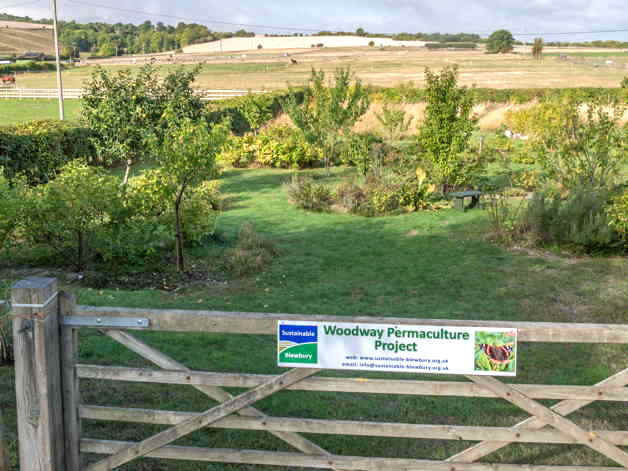
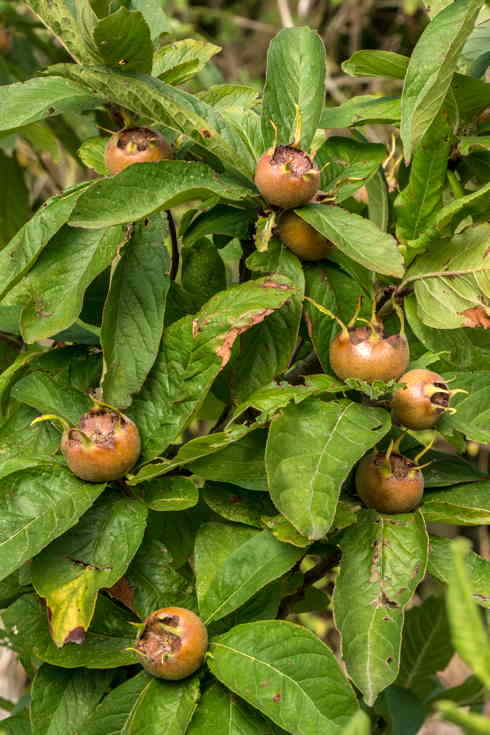
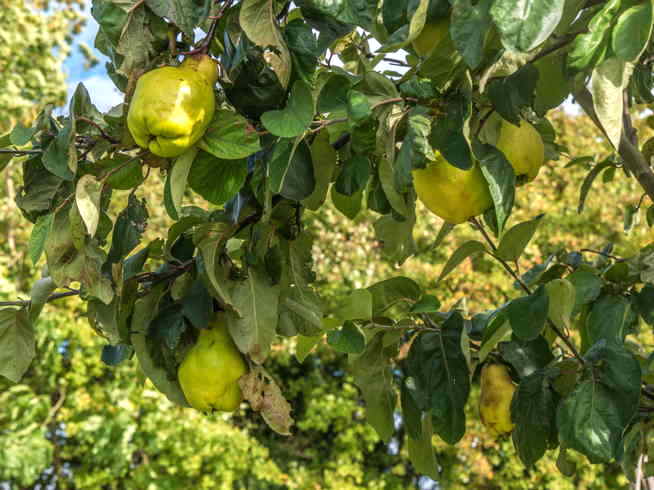
2019 was a mixed year. Some crops grew well and produced good crops, while others (notably cherries and plums) were hit by three consecutive nights of hard frost at the peak of blossoming. Soft fruit was mixed, and the berry bushes (jostaberry, boysenberry) that had good crops were attacked as never before by blackbirds. We had a plum tree that had been purchased a couple of years earlier as a Cambridge Gage but turned out not to be, so we also bought a genuine Cambridge gage but also kept the incorrect tree, but it never did well and in 2019 it died. We have now replaced it with a Jubilee Plum. In March 2020 we were given a Sea-buckthorn. now planted in the south-west corner.
2020 was a pandemic year, and we did little due to other illness. 2021 started with some late-May frost destroying plum and other crops, but we did get some quinces, berries, and for the second year in a row a lot of medlars that we turned into jelly to sell.
In autumn 2021 the SB hedge-laying group had training sessions on our hedge and then laid the entire hedge on the south and west of the field. The photo below shows part of the completed hedge.
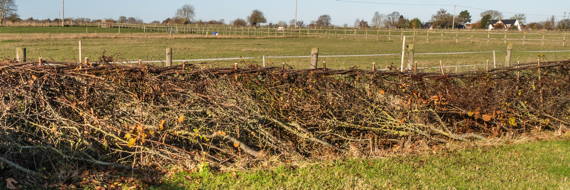
Plans for the future
Permaculture aims to use all available space, so we are planting multiple layers. We will continue to add perennial herbs, ground cover, vegetables and climbers, using the trees for support. With more effort, we could extend the cultivated beds to the western area of the plot currently left unmowed.
For more information about this project, please contact
Eric Eisenhandler:![]()
The Permaculture
Association website has a wide range of information on permaculture courses,
projects, developments and news. There is also a good ‘Knowledge Base’ which
contains articles about permaculture ranging from the basics to more specialised
information.
Permanent Publications publishes the excellent quarterly magazine Permaculture
– Inspiration for Sustainable Living, and sells a range of permaculture
books.
The Agroforestry Research Trust provides information on plants for forest
gardens, and also supplies them.
Plants for a Future gives information on edible, medicinal and otherwise useful
plants that may not be well known. This is a very useful resource to enlarge
your knowledge about plant varieties and for choosing plants for a permaculture
system.
